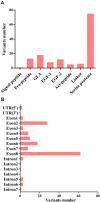Clinical analysis and quality of life survey of hemophilia B patients in the central and western regions of China
- PMID: 38783919
- PMCID: PMC11111977
- DOI: 10.3389/fped.2024.1366990
Clinical analysis and quality of life survey of hemophilia B patients in the central and western regions of China
Abstract
Objective: To study the current status of hemophilia B (HB) patients in the central and western regions of China.
Methods: This cross-sectional, multicenter study was conducted in seven provinces in the central and western regions of China from April 2019 to June 2023. Samples were collected for the factor IX activity, inhibitor screen, and gene mutation. Furthermore, the status of six index joints and quality of life (QoL) were assessed.
Results: A total of 185 HB patients (mild 15, moderate 75, and severe 95) with a median age of 12.17 years were enrolled. 30.3% (56/185) of patients had a family history of HB. 34.6% (64/185) of HB patients had diagnostic delay and 38.5% (69/179) experienced treatment delay. The incidence of inhibitors was 6.1% (11/179). We identified 123 genetic variants in this study, with missense mutations being the most common. 84.0% (89/106) of HB mothers were genetically identified as carriers, with 27.7% (13/47) of carriers having clotting factor levels less than 0.40 IU/ml. 71.4% (132/185) of HB patients had a history of joint hemorrhage, with a rate of target joint in these patients was 64.4% (85/132). Lower extremity joints were most often affected in patients. The Hemophilia Joint Health Score (HJHS) score was significantly positively correlated with the Hemophilia Early Arthropathy Detection with Ultrasound in China (HEAD-US-C) (r = 0.542, P < 0.001). Patients who received prevention treatment, inhibitor negative, without treatment delay, and without high-intensity replacement therapy showed a higher total score of the short form-36 health survey (SF-36).
Conclusions: One-third of HB patients had delay in diagnosis and treatment, and the incidence of inhibitors was 6.1%. Target joints were present in nearly half of HB patients. Missense was the main mutation type. 84.0% of mothers of HB patients in this study were found to be carriers. HEAD-US-C and HJHS can complement each other in the evaluation of joint status and give a valid basis for early clinical management. Early detection and preventive treatment, as well as reducing high-intensity replacement therapy and inhibitor generation, can effectively improve the QoL of patients.
Keywords: carriers; gene mutation; hemophilia B; joint status; quality of life.
© 2024 Wang, Xu, Wu, Liu, Jin, Huang, Xu, Huang, Li, Liu, Zhang, Zhou, Peng and Hu.
Conflict of interest statement
The authors declare that the research was conducted in the absence of any commercial or financial relationships that could be construed as a potential conflict of interest.
Figures




Similar articles
-
Clinical Analysis and Mental Health Survey of Hemophilia Carriers: a Cross-sectional Study.Curr Med Sci. 2024 Apr;44(2):435-440. doi: 10.1007/s11596-024-2855-5. Epub 2024 Apr 2. Curr Med Sci. 2024. PMID: 38561593
-
[HEAD-US-C quantitative ultrasound assessment scale in evaluation of joint damage in patients with moderate or severe hemophilia A received on-demand versus prophylaxis replacement therapy].Zhonghua Xue Ye Xue Za Zhi. 2018 Oct 14;39(10):817-821. doi: 10.3760/cma.j.issn.0253-2727.2018.10.006. Zhonghua Xue Ye Xue Za Zhi. 2018. PMID: 30369202 Free PMC article. Chinese.
-
Joint status and related risk factors in patients with severe hemophilia A: a single-center cross-sectional study.Hematology. 2022 Dec;27(1):80-87. doi: 10.1080/16078454.2021.2019892. Hematology. 2022. PMID: 34964431
-
Hemophilia A and hemophilia B: focus on arthropathy and variables affecting bleeding severity and prophylaxis.J Thromb Haemost. 2013 Aug;11(8):1449-53. doi: 10.1111/jth.12317. J Thromb Haemost. 2013. PMID: 23763284 Review.
-
Is haemophilia B less severe than haemophilia A?Haemophilia. 2013 Jul;19(4):499-502. doi: 10.1111/hae.12133. Epub 2013 Mar 21. Haemophilia. 2013. PMID: 23517072 Review.
References
LinkOut - more resources
Full Text Sources
Miscellaneous

